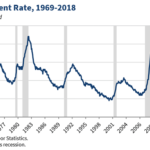4% Unemployment Makes Employee Engagement CRUCIAL
I believe we have the capability to innovate our way out of anything. The problem is, we generally don’t act until there is a crisis. When unemployment was in double figures, there was no compelling reason to pay attention to the importance of engaging employees. After all, where were they going to go? It was tough “out there” and they were unlikely to walk out the door.
Even if you’re a kind soul who truly cares about your team, there’s still a good chance you have not been giving enough attention to engaging your employees. You’re busy; you have a lot to do.
 Consider this your wake-up call. Your employees now have many options, especially your top performers. Unemployment is at 4%. Take your team for granted at your peril. There IS a crisis; time to innovate.
Consider this your wake-up call. Your employees now have many options, especially your top performers. Unemployment is at 4%. Take your team for granted at your peril. There IS a crisis; time to innovate.
At a time of year when most organizations are looking at budgets, an equally important task is to look just as closely at your employee engagement. There are numerous ways to measure it: use of employee benefits, mistakes made, customer accolades versus complaints, productivity, etc. My guess, however, is that you already know whether your employees are engaged. You can tell by the energy (or lack thereof) at your work place.
If there is one thing you can do this year to ensure growth and/or increased productivity, it is to focus on ways to engage your team more fully. Unfortunately, this is often not even on most leaders’ radar. It’s too easy to decide that it’s hopeless– people will be people – I can’t do anything about whether or not they are engaged.
How do you know? Have you even tried?
First of all, you get more of what you focus on. The moment you shift your focus from, “What’s the use?” to “Let’s see what we can make happen,” you will begin to see an uptick in engagement. Add to that some simple approaches:
- Before going straight to your work area at the beginning of your day, make an effort to greet everyone on your team. If they respond with a puzzled look and ask, “Who are you again?” you know it’s a bigger problem than you feared.
- “Catch” people doing something right.
- Say “thank you” and be specific about what you’re thanking them for.
- Write them up for doing something well versus writing them up for mistakes.
These are just a few ways to engage your employees, there are many more. Those listed above don’t take a lot of time; they do take focus.
Why not try them out? Be innovative! What have you got to lose?
“There is a principle which is a bar against all information, which is proof against all arguments, and which cannot fail to keep a man in everlasting ignorance—that principle is contempt prior to investigation.” – Herbert Spencer
Or, as the old TV slogan encouraged us, “Try it; you’ll LIKE it!”
Appreciation = “I notice”

I’ve written about this before but it bears repeating.
We seem to make a very big deal about employee engagement. We conduct surveys, put in systems and programs to address the issues and yet nothing seems to improve.
Perhaps we are overcomplicating things.
Our employees and co-workers (our families!) all want to feel appreciated. We want to fulfill those desires.
Here is a simple way to show appreciation in any situation: simply notice what others are doing and tell them you noticed.
To the receptionist: “I’ve noticed that, when things are slow for you, you ask your co-workers if there’s anything you can do for them. Thank you for that.”
To the maintenance person, “I see that not only are the floors clean but the baseboards are, as well. Not everyone takes that extra step. Thank you.”
To your boss, “Whenever you want to speak to me you always ask if it’s a good time. I really appreciate that consideration.”
Take a moment to think about those around you. What do they do, without being asked, that is noteworthy? When I say “noteworthy” I don’t mean that it has to be a big deal. It’s just something they do that makes work more pleasant.
Another way to think about it is, what do you complain about others doing? Are there people around you who DON’T do that? Have you told them how much you appreciate it? Here’s an example: when I am in a restaurant and telling a story, I really don’t like it if the server interrupts. First of all, have you noticed it’s usually when you’re in the middle of the punch line? Therefore, whenever a server waits for me or anyone else at the table to stop talking before interrupting, I always let them know how much I appreciate it.
You might say, “Well, Silver. That’s how they are SUPPOSED to behave,” and you would be correct. That doesn’t mean they don’t deserve to be thanked for it. Keep your focus on what people do that pleases you, thank them for it and engagement will naturally increase.
Change your focus; engage your team!
What’s Your Employee Engagement Objective?
No less a business icon than Henry Ford, founder of Ford Motors famously advised, “If you always do what you’ve always done, you’ll always get what you’ve always got.”

What is the “always done” in your organization when it comes to engaging your employees in the day-to-day work?
When was the last time you considered what your objectives should be as related to inspiring your team toward greater engagement?’
If I haven’t yet grabbed your attention, if you’re rolling your eyes and muttering under your breath, “Here we go; more of that touch-feely stuff,” then let’s use an objective that will get your attention: INCREASED PRODUCTIVITY.
Study after study tells us unequivocally that an engaged workforce is a productive workforce. What do I mean when I say engaged? Employee Engagement is defined as the opportunity to use your creativity on a daily basis. When jobs become, “same old/same old” routines, employees quickly become disengaged and productivity drops. The drop may not be evident if you continue to successfully get the product out the door. Decreased productivity manifests in other ways:
- An increase in the amount of time it takes to get the same amount of product out the door
- More mistakes even though processes are the same (which is likely why there are more mistakes)
- General sloppiness – in the physical space, paperwork, and/or communication.
In order to define your Employee Engagement objectives, take a look at your stats. Where are the productivity leaks? How are you addressing them? And here is the most important question: what is your plan for getting your employees directly involved in addressing them? Believe me when I tell you they want to be asked. Depending on your culture and how far it has devolved, you may need to give them the opportunity to address these issues in some way other than a group meeting (who wants to stick their neck out in a group?). Here are some ideas:
- A survey conducted by an outside entity where they are guaranteed their responses will be confidential
- One-on-one meetings that are collaborative in nature, versus confrontational
- Use a fun, incredibly productive collaborative, team-building tool such as a World Cafe. I used this approach early in 2017 with a public sector group going through an upsetting amount of change. Their new Director was skeptical about his team opening up because he had trouble getting them to talk about these issues. Surprise, surprise! They came to life in the World Cafe and came up with incredible solutions to their issues. And the good news? Because these solutions were their ideas, they got implemented as agreed!
So what ARE your Employee Engagement objectives? Give it some thought. In the immortal words of Yogi Berra, “It ain’t over till it’s over!”
HOW MUCH Does Employee Disengagement Cost?!?
ADP (the payroll giant) puts the cost of employee disengagement at an average of $2,634/year. That’s an average. If your more highly paid employees are checked out then the cost increases dramatically. Since the 2014 Gallup Poll revealed that 70% of employees are disengaged, it means your organization could be bleeding money — and not slowly!
Where do these costs come from?
- Low productivity
- Lower sales
- Missed opportunities
- More down time in terms of illness
- Increased use of medical and other employee benefits
- Damage to your brand as unhappy employees bad mouth your organization
To quote Sonny & Cher from their hit song “And the Beat Goes On.”
Delegation’s Role in Employee Engagement
According to Wikipedia, “Publish or perish” is a phrase coined to describe the pressure in academia to rapidly and continually publish academic work to sustain or further one’s career.

The equivalent in organizations would be, “Delegate or disintegrate.” Dramatic? Well, yes, but also true.
When the leaders within an organization do not know the subtleties and finesse required for delegating well, this lack of skill has a dramatic impact on employee engagement and ultimately the bottom line. Over time the result is a slow disintegration of your company, similar to the damage caused by water dripping on a rock.
Here are just a few ways in which your organization is impacted by leadership’s lack of delegation skills:
An inability to hire top talent
We are in an age of over communication. If your company has lackluster leadership and widespread employee disengagement, it is well known within your industry. Although you may be able to hire, you won’t attract the most talented because they have options. These are the individuals who strategically choose the companies they work for with an eye toward enhancing their resumes. Your company’s reputation will be considered strongly when they make career decisions.
Employee Turnover
Most experts conservatively estimate the cost to find and train a replacement to be one and a half to more than twice a staffer’s salary. Why?
- Reduced productivity,
- Organizational wisdom that walks out the door with the employee
- Time taken up by the hiring manager and human resources
- An overworked and stressed remaining staff
- Training expenses
- The direct costs of hiring such as advertising and recruiter fees.
There is an adage, “People don’t leave jobs, they leave bosses,” and although there are a myriad of reasons why people leave a job, the direct supervisor has the most impact on their job satisfaction. When the supervisor is a poor delegator, the result is employees who are discouraged and disengaged.
Increased cost of productivity
A question every leader should take time to ponder is: why is it we don’t have the time to clearly delegate tasks and projects at the beginning but we always have time to clean up the mess when they are not done properly?
Take a look at the “do overs” within your area of responsibility and spend some time tracing the root cause. Often mistakes are made for a couple of reasons:
- The person delegating the task or project has not clearly defined the expectations and the required results.
- The person to whom the task was delegated did not have all the information required to do the job and did not feel engaged in the process.
I have heard far too many managers say, “My employees will come to me if they have questions.” Please believe that, no matter how good your relationship, most employees are reluctant to voluntarily display their lack of knowledge, especially to their boss.
Loss of employee development
There lies within the delegation of every task or project an opportunity to further develop the employee to whom you are delegating. When a leader spends time at the front end discussing how to achieve the required result there are opportunities to uncover any gaps in the employee’s knowledge and to coach the employee on how to achieve the result more efficiently.
Conclusion
Whether you are a C-Suite executive or a front line supervisor, the ability to delegate efficiently and effectively will not only make your job a great deal easier, it will ultimately add dollars to the company’s bottom line. Employee engagement will increase.
Instead of disintegrating, your company will flourish and excel—and so will your employees.
For information on how to delegate, refer to our earlier blog on the topic: http://silverspeaks.com/blogs/2015/12/socratic-delegation-whaaaatttt/
Click here for a PDF of this article
